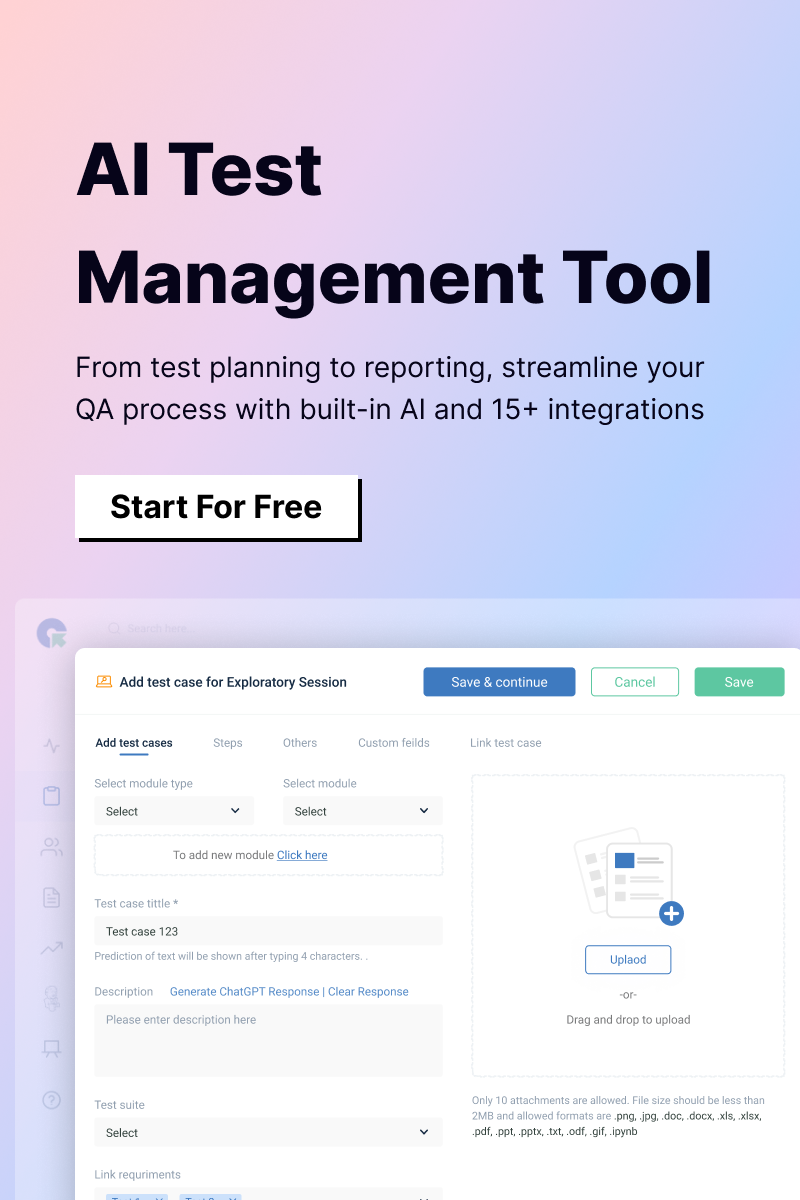Think of a game like a massive theme park. The rides (game mechanics) need to run smoothly, the maps (levels) should be easy to navigate, and the safety measures (security and stability) must be in place. Now, imagine if the roller coaster suddenly stopped mid-loop or the ticket booth crashed every time too many people lined up. That’s what an untested or poorly tested game feels like—frustrating, broken, and nowhere near the fun experience players expect.
Game QA testing is what keeps that theme park running flawlessly. It’s the behind-the-scenes process that ensures smooth gameplay, fair mechanics, and an immersive experience across different platforms. Whether it’s hunting down game-breaking bugs, stress-testing servers for multiplayer stability, or checking if that cool new feature actually works as intended, testing is the backbone of a polished gaming experience.
In this blog, we’ll explore the methodologies, challenges, and best practices of game QA testing—because in the end, the best games aren’t just fun; they’re built to last.
Understanding the Roles: Gamers and Testers
At first glance, gamers and testers might seem to have similar roles—both play games extensively. However, their objectives are vastly different. While gamers play for entertainment, testers play with a purpose: to break the game, find flaws, and make it better before it reaches the players.
Gamers are the heart of the industry. Their expectations drive the demand for better graphics, smoother mechanics, and engaging storylines. They interact with the final product, experiencing the game as intended. However, if a game is riddled with bugs or performance issues, they’re also the first to voice their dissatisfaction, influencing reviews, sales, and a game’s overall reputation.
Game testers, on the other hand, are the unsung heroes of the development process. Their job isn’t just to play—it’s to break. They push the game to its limits, testing mechanics, searching for inconsistencies, and identifying potential exploits. They run through every possible scenario, ensuring that everything from movement physics to online matchmaking works as expected.
Testers work closely with developers to report issues, provide feedback, and verify that fixes solve the problems without introducing new ones. Their meticulous attention to detail ensures that when the game finally reaches players, it delivers a smooth and immersive experience.
While gamers and testers share a love for games, their roles in the development process couldn’t be more different. One enjoys the adventure, while the other works tirelessly behind the scenes to make sure the adventure is flawless.
What is Game Testing?
Game testing, also known as game quality assurance (QA), is an important step in the game development lifecycle. It ensures that a game runs as intended, provides an engaging player experience, and is free from disruptive bugs, glitches, and performance issues. Unlike traditional software testing, where the focus is on functionality and security, game QA testing goes beyond that — it evaluates gameplay mechanics, graphics rendering, AI behavior, and even player immersion.
While both game testing and traditional software testing share core principles such as identifying defects and validating functionality, they differ in key areas:
- Interactivity & User Experience: Traditional software focuses on usability and functionality, whereas game QA testing prioritizes responsiveness, fairness, and engagement.
- Complex Scenarios: Games have unpredictable player behaviors, physics-based interactions, and dynamic AI elements that require extensive testing beyond fixed input-output scenarios.
- Performance & Graphics Testing: Unlike typical applications, games demand frame rate stability, visual rendering accuracy, and real-time physics simulation checks.
- Multiplayer & Network Testing: Online games need extensive stress testing to handle high player loads, synchronization issues, and server performance.
The Goals of Game QA Testing
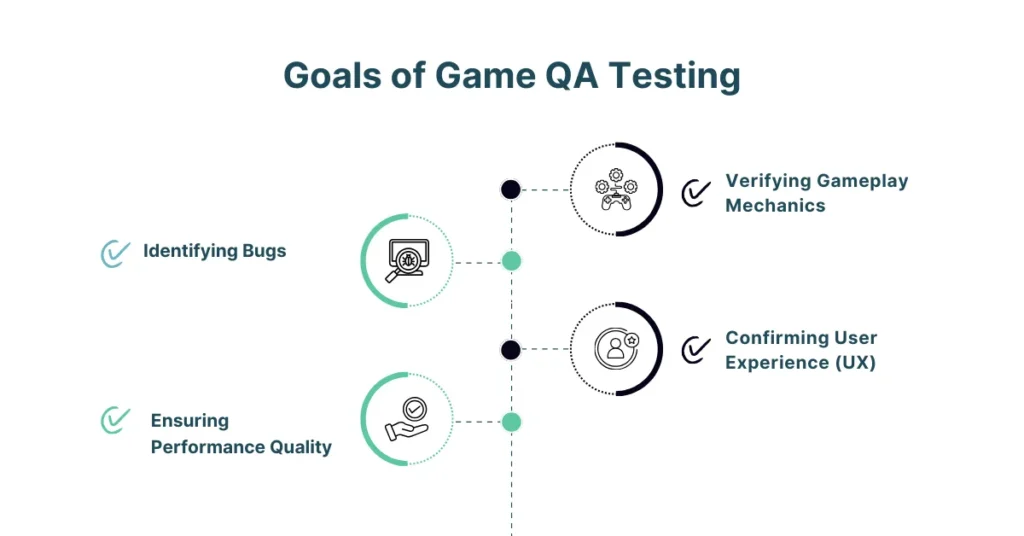
When it comes to game testing, several core goals must be met for an enjoyable gaming experience for users. Here are some primary goals:
- Identifying Bugs: One of the key aspects of game QA testing is finding and documenting any bugs or glitches through thorough testing. This includes visual errors, gameplay issues, crashes, or unexpected behavior that could disrupt the player’s experience.
- Ensuring Performance Quality: Game performance is crucial for a smooth experience. This includes evaluating frame rates, load times, and system resource usage across different platforms.
- Verifying Gameplay Mechanics: Testers verify that the core mechanics of the game work as intended. This includes ensuring that interactions, controls, and objectives function as expected, contributing to a smooth, enjoyable gaming experience.
- Confirming User Experience (UX): Testers also assess the overall user experience to ensure that the game is intuitive, engaging, and accessible to the target audience. This includes evaluating the game’s interface, navigation, and visual appeal.
Types of Game QA Testing
Game QA testing consists of various testing methodologies to identify bugs, optimize performance, and refine the overall player experience. Each type of testing serves a specific purpose, from verifying core functionalities to ensuring compatibility across devices and detecting security vulnerabilities. Here, we will explore the key types of game QA testing, their focus areas, and the methodologies used to maintain high-quality gaming experiences.
Functionality Testing:
This type of testing focuses on verifying that all game features and mechanics work as intended. Testers evaluate gameplay mechanics, controls, interactions, and game rules to ensure they are functioning correctly. It involves:
- Gameplay Mechanics: Functional testing verifies that the core gameplay mechanics, such as combat systems, puzzles, progression, and AI behaviors, are working correctly. Testers simulate various in-game actions to ensure they behave as expected under different scenarios.
- Controls: Testers check whether inputs (keyboard, controller, or touchscreen) result in the correct in-game actions, such as character movement, interactions with objects, or special abilities. Any delay or malfunction in controls could negatively impact the player’s experience.
- Game Features: All features of the game, including menus, multiplayer functionality, achievements, and in-game economy (if applicable), must work easily. Functional testing ensures that all features are implemented correctly and trigger the expected outcomes when interacted with.
- Input Handling and Output: Functional testing checks that all player inputs are processed and result in the correct outputs, such as character movements, item pickups, or interactions with non-playable characters (NPC). This includes verifying that no unexpected behavior occurs when interacting with the game world.
Compatibility Testing:
Compatibility testing ensures that the game performs well across different platforms, devices, and configurations. This includes testing on various operating systems, hardware configurations, screen resolutions, and input devices to ensure the game is accessible to a wide audience.
- Platform Compatibility: A game may be released on multiple platforms such as Windows, macOS, PlayStation, Xbox, and mobile devices. Compatibility testing checks that the game runs smoothly on each of these platforms, considering their unique operating systems, hardware specifications, and performance capabilities.
- Device Compatibility: For games targeting mobile devices, compatibility testing ensures that the game runs properly on a wide range of smartphones and tablets, from the latest models to older or less powerful devices. It checks factors such as screen resolution, touch controls, and hardware limitations to ensure a consistent experience across devices with varying specifications.
- Browser Compatibility: For browser-based games or games with online features, compatibility testing is performed to check if the game works across different web browsers (e.g., Chrome, Firefox, Safari, Edge). This includes inspecting the game’s functionality, visuals, and performance in each browser to ensure it loads correctly and runs without issues.
- Operating System Compatibility: Compatibility testing verifies that the game works across various operating systems, such as different versions of Windows, macOS, Linux, and mobile OSes (iOS and Android). This is important for identifying any OS-specific bugs or issues related to how the game interacts with the system.
- Hardware Configuration Testing: Different players will have varying hardware setups, including different types of graphics cards, processors, and RAM configurations. Compatibility testing ensures that the game can handle these variations and deliver optimal performance across a wide range of hardware configurations, from high-end gaming rigs to more basic setups.
- Network and Connectivity Compatibility: For online multiplayer games, compatibility testing ensures that the game functions well with various network environments, whether players are using Wi-Fi, mobile data, or LAN connections. This ensures smooth connectivity and minimizes issues such as lag, disconnections, or performance drops.
- Ensuring Consistency: Ultimately, compatibility testing ensures that the game delivers a consistent, high-quality experience regardless of the platform, device, or configuration a player is using. This helps improve user satisfaction and ensures that the game reaches a broad audience without compromising on performance or functionality.
Usability Testing:
Usability testing focuses on evaluating the game’s user interface, menus, tutorials, and overall user experience to ensure it is intuitive, easy to navigate, and enjoyable for players. The goal is to ensure that players can easily understand and navigate the game without confusion, frustration, or unnecessary complexity. Here’s why usability testing is so important:
- Player Experience Evaluation: Usability testing helps assess how well the game meets the expectations of its target audience. Testers observe players’ reactions to the game, identifying areas where players may struggle or experience frustration. This feedback is critical to fine-tuning the game’s interface, mechanics, and overall experience.
- Intuitiveness: Games need to be intuitive, meaning players should be able to grasp the gameplay mechanics and controls quickly without requiring extensive tutorials or external help. Usability testing helps determine if the game’s learning curve is manageable.
- Game Accessibility: Usability testing also ensures that the game is accessible to a wide range of players, including those with varying levels of skill, knowledge, and potential disabilities. Testers evaluate whether in-game elements, such as buttons, menus, and controls, are easy to interact with and if they accommodate diverse player needs.
- Enjoyability and Engagement: Beyond functionality, usability testing evaluates whether the game is fun and engaging. It focuses on aspects such as game flow, pacing, narrative immersion, and the ease with which players progress. Positive usability testing results suggest that the game provides an enjoyable experience that keeps players hooked.
Localization Testing:
Localization testing involves testing the game’s language translations, cultural appropriateness, and regional content to ensure it resonates with players from different regions and cultures. It ensures that the game not only translates text correctly but also adapts cultural references, visuals, and gameplay elements to resonate with players from different backgrounds. Here’s why localization testing is important:
- Accurate Language Translations: Localization testing verifies that all in-game text, including dialogue, menus, instructions, and story elements, is translated correctly. It’s not just about translating words but ensuring that the meaning, tone, and context of the original content are preserved in the target language. Mistranslations can lead to confusion or a loss of intended humor or emotion.
- Cultural Sensitivity and Relevance: Localization testing checks that the game’s content, including visual elements, names, symbols, and references, aligns with the cultural norms and values of the target audience. For example, certain colors, gestures, or themes might be interpreted differently or be inappropriate in certain cultures. Adjusting these elements ensures the game doesn’t unintentionally offend or confuse players.
- Adapting Gameplay Elements: Besides text and visuals, localization may also involve adjusting gameplay mechanics or difficulty levels to suit local preferences. For instance, some regions might have specific preferences for gameplay style, difficulty, or certain types of content, such as sports or humor. Localization testing helps ensure these elements align with local tastes.
- Formatting and Layout: Different languages have different lengths for words or phrases, which may affect how text fits into UI elements such as buttons, dialogue boxes, or menus. Localization testing ensures that the UI design adapts to these differences without causing issues such as text overlap or misalignment, preserving the overall design and user experience.
- Audio and Voiceovers: For games with voiceovers or audio dialogues, localization testing ensures that the new voice acting matches the translated script, maintaining the emotional tone and personality of the characters. Additionally, it’s important to confirm that lip-syncing and facial expressions remain consistent across languages.
Performance Testing:
Performance Testing in game development is important for assessing how well the game runs under different conditions to deliver a smooth and responsive experience for players. This testing focuses on several key areas, including responsiveness, load times, and stability, while also evaluating how the game handles peak loads. Here’s a breakdown of what performance testing entails:
- Responsiveness Testing: Performance testing evaluates how quickly and smoothly the game responds to player inputs. This includes checking the time it takes for actions such as moving characters, switching between menus, or activating in-game abilities. Any delays or lag can significantly impact the player’s experience.
- Load Time Testing: Load times are a major factor in player satisfaction. Performance testing ensures that the game loads efficiently, both when launching the game initially and when transitioning between levels, scenes, or menus. Long load times can be frustrating for players, and performance testing identifies any bottlenecks or delays in loading assets, environments, or game states.
- Stability Testing: Stability testing evaluates how the game performs over an extended period. This includes checking for crashes, freezes, or other issues that could arise after prolonged gameplay sessions. Ensuring stability helps prevent the game from deteriorating in performance, which could lead to poor player experiences or game abandonment.
- Stress Testing: Stress testing is a key component of performance testing that assesses how the game performs under extreme conditions, such as high player counts, resource-intensive actions, or simulated network instability. For multiplayer or online games, stress testing is especially important to ensure the server infrastructure can handle peak traffic and that gameplay doesn’t degrade under heavy load.
- Platform-Specific Performance: Games are often released on multiple platforms (PC, consoles, mobile, etc.), and each platform may have different hardware and performance capabilities. Performance testing ensures that the game performs optimally across all supported devices, with particular attention to each platform’s unique performance requirements.
- Optimization: After identifying performance bottlenecks or areas that may cause issues, optimization efforts are made to improve the game’s efficiency. This could involve optimizing graphics, streamlining code, or adjusting resource usage to ensure the game runs smoothly on a wide range of devices.
Regression Testing:
Regression testing is conducted to verify that new updates, patches, or changes to the game do not introduce any new bugs or regressions into the existing codebase. In game development, where continuous changes are made to improve performance or add new content, it’s important to verify that these changes don’t cause unintended side effects. Here’s how regression testing contributes to maintaining a stable game:
- Verifying Existing Features: The primary goal of regression testing is to ensure that existing features and functions continue to operate as expected after changes have been made. This includes testing all previously working mechanics, gameplay features, and systems to ensure they still function correctly, even after bug fixes or updates.
- Identifying Unintended Issues: When new updates are introduced, there’s a risk of introducing new bugs or glitches that could affect previously stable parts of the game. Regression testing helps identify these issues early by re-running tests on the existing game features, highlighting any problems introduced by new code changes.
- Maintaining Game Balance: Game updates or new content often involve changes to mechanics, character stats, or level designs. Regression testing checks that these changes don’t unintentionally disturb the balance of the game. For example, a fix for one character’s ability shouldn’t cause another character’s ability to behave incorrectly or break the overall gameplay experience.
- Ensuring Stability: As games grow more complex with additional content, updates, or platform support, it becomes increasingly important to maintain stability. Regression testing helps ensure that new changes don’t negatively affect game stability, ensuring smooth performance on all supported devices and configurations.
- Continuous Monitoring: As part of ongoing development, regression testing is performed after every major update or new release. This ongoing process guarantees that the game remains reliable throughout its lifecycle, even as features evolve and new content is added.
Security Testing:
Security testing assesses the game’s vulnerability to security threats such as hacking, cheating, data breaches, and unauthorized access, and implements measures to protect player data and ensure fair gameplay. As online games increasingly involve player interactions, in-game purchases, and personal data, it’s crucial to assess the game’s defenses against hacking, cheating, data breaches, and unauthorized access. Here’s how security testing plays a key role in safeguarding both the game and its players:
- Identifying Vulnerabilities to Hacking: One of the main goals of security testing is to detect any weaknesses in the game’s code, server-side architecture, or user authentication processes that could be exploited by hackers. This could include potential entry points for malicious attacks that could disrupt gameplay, steal data, or manipulate game outcomes.
- Preventing Cheating: Online multiplayer games are often targeted by cheaters who use hacks or bots to gain unfair advantages. Security testing involves checking anti-cheat mechanisms to ensure they are effective in detecting and blocking cheating tools. This also includes validating that the game’s servers can securely track player actions and prevent manipulation of game data, such as scores or resources.
- Protecting Player Data: Games that collect personal information, payment details, or other sensitive data must adhere to strong security practices. Security testing ensures that player data is encrypted and stored securely, with measures in place to prevent data breaches or unauthorized access. This includes evaluating data transmission methods, such as ensuring that all communication between the game client and servers is secure (e.g., using HTTPS protocols).
- Ensuring Fair Gameplay: Security testing ensures that the game’s features, such as matchmaking, progress tracking, and in-game purchases, are fair and not subject to manipulation. This includes testing for vulnerabilities in the game’s logic that could be exploited to gain unfair advantages, like bypassing level requirements or gaining unlimited in-game currency.
- Testing for Authentication and Authorization Issues: Security testing also involves checking the game’s authentication processes, ensuring that only authorized players can access specific accounts or game content. This includes verifying secure login mechanisms, such as two-factor authentication, and ensuring that account information is protected from unauthorized access.
- Simulating Attacks: Ethical hackers or penetration testers often simulate real-world attacks (e.g., SQL injection, denial-of-service attacks) to identify vulnerabilities that could be exploited. By simulating these attacks, developers can understand how their game responds to potential threats and patch up weaknesses before launch.
- Compliance with Regulations: In some regions, there are strict regulations regarding data protection (such as GDPR or CCPA). Security testing ensures that the game complies with relevant legal requirements regarding player data privacy and security.
The Game QA Testing Process
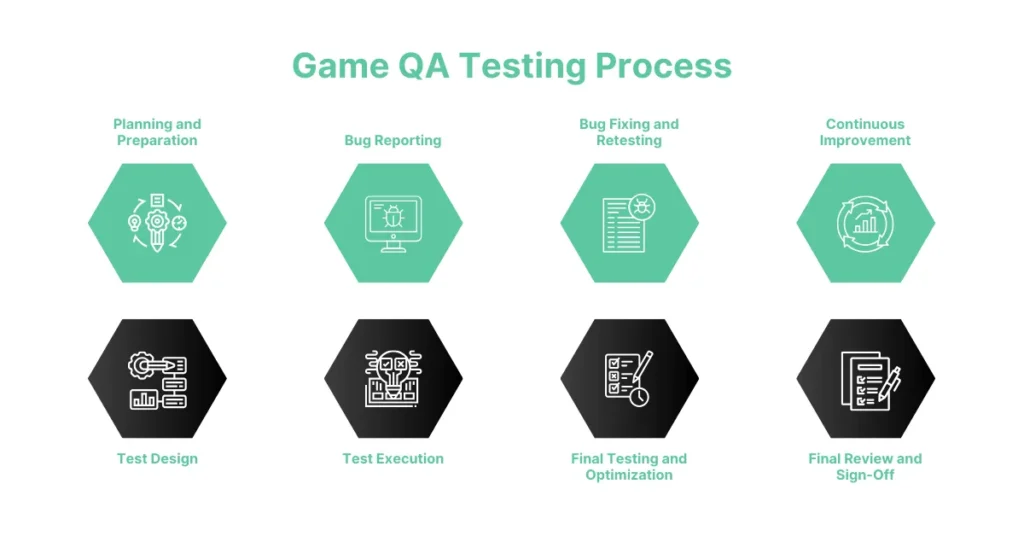
The Game QA Testing Process is a structured approach that ensures a game is free of bugs, functions properly, and provides a great player experience before its release. Here’s the typical process followed in game QA testing, detailing each stage from planning to execution:
1. Planning and Preparation
- Defining Scope and Objectives: The first step in game QA testing is to define the scope of the testing process. This involves identifying which features and aspects of the game will be tested (e.g., gameplay mechanics, graphics, performance). Clear objectives are set, such as ensuring a smooth user experience, identifying bugs, or testing for performance stability.
- Resource Allocation: The testing team is assembled, and resources such as testing tools, environments, and test devices are prepared. The roles and responsibilities of each team member are defined to streamline the testing process.
- Test Plan Creation: A comprehensive test plan is developed, outlining the testing methods, schedules, and types of testing to be performed. This also includes determining which platforms and devices the game will be tested on.
2. Test Design
- Test Case Creation: Based on the game’s features and design, specific test cases are created to evaluate the game’s functions, performance, and user experience. Test cases are written for various scenarios, including both expected and unexpected player actions.
- Test Script Development: For automated testing, test scripts are written to perform specific tasks within the game. This can include testing gameplay functionality, load times, or ensuring that bugs do not reappear after fixes.
3. Test Execution
- Manual Testing: In manual testing, testers play the game themselves, following the test cases, to identify issues such as bugs, glitches, and gameplay inconsistencies. This stage often involves exploratory testing, where testers deviate from predefined cases to discover hidden problems.
- Automated Testing: For repetitive or time-consuming tests (e.g., load testing, regression testing), automated testing tools are used to speed up the process. These tools simulate user interactions and check for performance or functionality issues.
- Specialized Testing: Specific types of testing, such as performance, security, and compatibility testing, are executed during this phase to evaluate the game’s behavior under different conditions.
4. Bug Reporting
- Bug Identification: During testing, bugs, glitches, and other issues are identified, documented, and tracked. Testers record detailed information about the problem, including the steps to reproduce the issue, the severity of the bug, and its impact on the game’s overall experience.
- Bug Classification: Bugs are classified by priority (e.g., critical, major, minor) to help the development team address the most impactful issues first. Critical bugs that prevent gameplay from functioning properly are given the highest priority.
- Bug Submission: Bugs are submitted to the development team through a bug-tracking system, and a timeline for addressing the issues is established.
5. Bug Fixing and Retesting
- Fixing Issues: The development team works on fixing the bugs identified during testing. This may involve debugging code, optimizing assets, or making changes to the game mechanics.
- Retesting: Once the fixes are implemented, testers re-execute the test cases to verify that the issues have been resolved and that no new bugs have been introduced. This may involve both functional and regression testing to ensure that the game remains stable after updates.
- Iteration: The process of identifying, fixing, and retesting continues in iterations until all major bugs are resolved and the game meets the defined quality standards.
6. Final Testing and Optimization
- Performance Testing: Before the game is ready for release, extensive performance testing is done to ensure that it runs smoothly under various conditions, such as high player loads or stress situations.
- Compatibility Testing: Compatibility testing ensures the game works on all intended platforms and devices. This includes testing for hardware and software compatibility, ensuring a smooth experience across different configurations.
- User Experience Testing: This phase involves evaluating the overall player experience, including game mechanics, user interface, and overall enjoyment. Testers verify that the game is intuitive and engaging for the target audience.
7. Final Review and Sign-Off
- Quality Assurance Review: After all testing is complete and the issues have been addressed, the quality assurance team conducts a final review of the game to ensure that all objectives have been met and that the game is ready for release.
- Release Readiness: If the game meets all quality standards, it is signed off as ‘release-ready’ and is prepared for deployment. This includes packaging the game for distribution and performing any last-minute checks.
- Post-Release Monitoring: After the game is released, post-launch monitoring is conducted to track any issues that players may encounter. This helps identify and address any bugs or performance issues that may arise after the game has been launched.
8. Continuous Improvement
- Updates and Patches: Even after the game is released, testing doesn’t stop. As updates, expansions, or patches are introduced, the testing process is repeated to ensure that the new content works properly and does not introduce any new issues.
Challenges in Game QA Testing
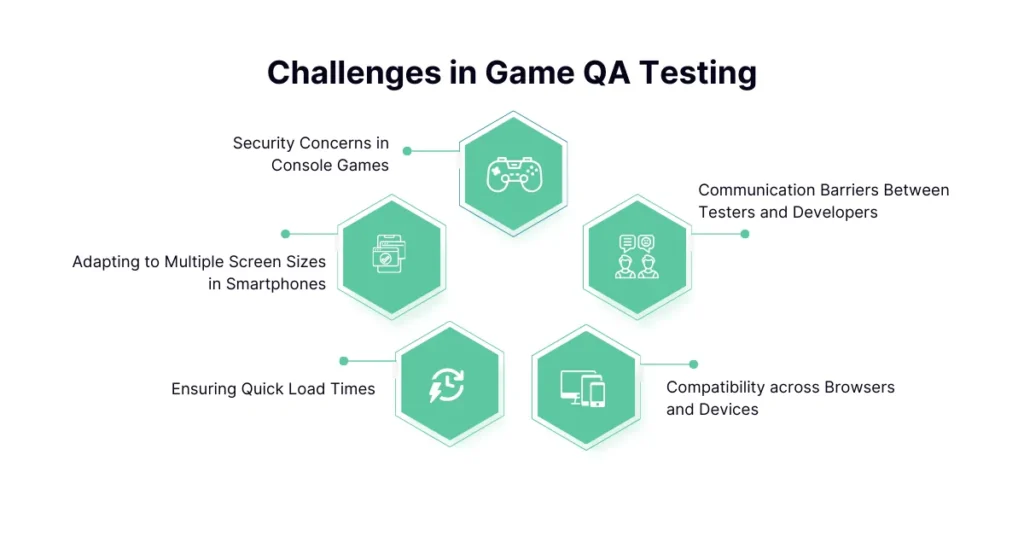
Game QA testing ensures that a game meets the expected quality and offers a smooth experience. However, it often comes with its own set of challenges. Let’s explore some of the key difficulties game testers face:
1. Security Concerns in Console Games
Ensuring that the game is secure is a major concern, especially with console games. Hackers often target these platforms to manipulate gameplay or steal data, leading to a compromised experience for players. Game testers need to constantly monitor for vulnerabilities, test for potential exploits, and implement strong security protocols to prevent unauthorized access, cheating, or data breaches.
2. Adapting to Multiple Screen Sizes in Smartphones
Smartphones come in a wide range of screen sizes and resolutions, making it a tough task for testers to ensure the game functions properly across all devices. A game that works perfectly on one screen might face layout or functionality issues on another. Game QA testers need to check and adjust for responsive design, ensuring the user interface adapts smoothly to different screen sizes.
3. Ensuring Quick Load Times
Often, players expect games to load within a few seconds. A slow loading time of more than 4 seconds can result in frustration, causing users to abandon the game. This is particularly challenging when dealing with large game files or high-quality graphics. Testers must assess load times on different devices and network conditions, ensuring optimal performance.
4. Compatibility across Browsers and Devices
With a wide range of web browsers (Chrome, Firefox, Safari, etc.) and devices (PCs, consoles, smartphones, etc.) available, ensuring a game is compatible across all platforms can be incredibly challenging. Each browser or device may behave differently, affecting gameplay performance. Compatibility testing across multiple environments, such as various browsers, operating systems, and hardware configurations will help in consistent functionality and appearance.
5. Communication Barriers Between Testers and Developers
Often, game QA testers and developers face communication gaps, which can lead to misunderstandings about expectations, requirements, or issues in the game. Each game app is unique, and the set of guidelines provided by developers might sometimes be difficult to follow or too vague. Clear and constant communication between testers, developers, and other stakeholders is crucial. Regular meetings, comprehensive documentation, and transparent feedback loops can help bridge the gap.
Best Practices for Effective Game QA Testing
Effective game QA testing is essential to ensuring that a game is polished, secure, and enjoyable for players. To enhance the testing process and achieve high-quality releases, game testers should follow best practices that contribute to a smoother development cycle and a more successful end product. Here are some actionable best practices for enhancing game QA testing efforts:
Early Involvement of Testers
Testers should participate in the initial planning stages, helping to define test requirements and providing input on potential risks and challenges. By understanding the game mechanics and goals from the beginning, testers can better tailor their testing strategies and catch potential issues early. This prevents costly fixes during later stages of development and improves overall quality by allowing for early feedback on design, functionality, and usability.
Continuous Integration and Testing
Continuous integration (CI) ensures that new code changes are automatically tested to detect defects quickly. Implement automated testing within the CI pipeline to quickly identify regressions or functional issues as the game evolves. This enables frequent and efficient testing, ensures code quality, and reduces manual effort. It also supports early detection of bugs, improving turnaround times for fixing issues.
Emphasizing Player-Centric Testing
Focusing on player-centric testing ensures that the game meets user expectations and provides an engaging and intuitive experience. Incorporate usability testing and user feedback early and often throughout development. Ensure that the game is fun, intuitive, and emotionally engaging from a player’s perspective.
Collaboration Between Development and Testing Teams
A lack of communication between development and testing teams can lead to misunderstandings, delays, and inefficient problem-solving. Foster a culture of open communication and collaboration between developers, testers, and other stakeholders. Hold regular meetings to discuss progress, challenges, and any new issues discovered during testing.
Documentation and Reporting Best Practices
Proper documentation ensures that developers understand exactly what needs to be fixed and helps keep everyone informed about the current state of the game. Create detailed bug reports with clear steps to reproduce, expected vs. actual results, and severity ratings. Keep track of test cases, test environments, and test results. Use bug-tracking tools to organize and prioritize issues, ensuring that nothing falls through the cracks.
Tools for Game QA Testing
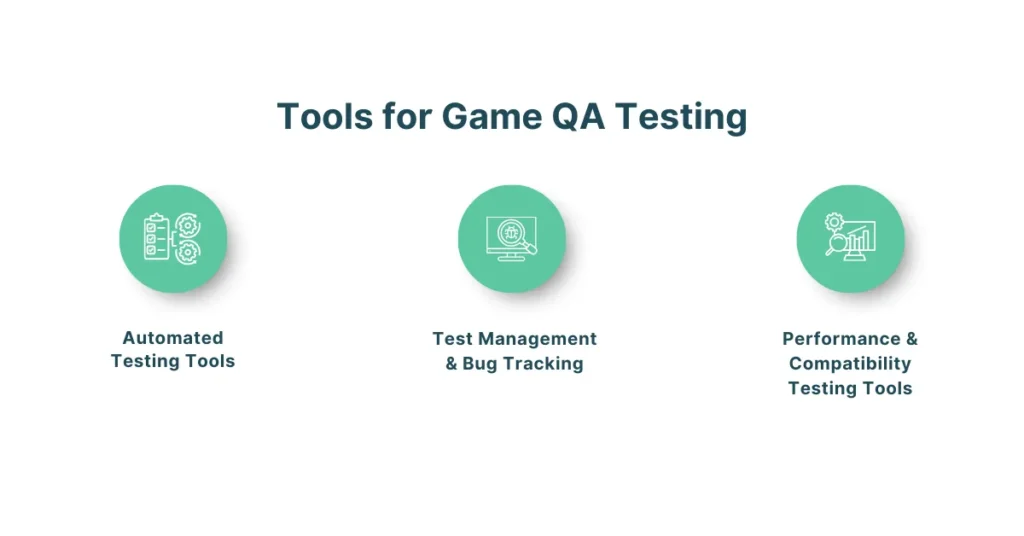
Game QA testing relies on a variety of tools and technologies to improve accuracy, and enhance efficiency. These tools help testers identify bugs, manage test cases, track issues, and automate testing for different game elements. Here, we will explore essential game QA testing tools based on their functionality, covering test automation, bug tracking, performance analysis, and compatibility testing solutions.
1. Automated Testing Tools
- Unity Test Framework – A built-in framework for Unity developers to create and run automated tests for Unity games.
- Unreal Engine Testing Framework – A testing framework for Unreal Engine developers to automate and execute tests within the game engine.
- GameMaker Studio – Provides debugging and testing tools to streamline game development and identify errors early.
2. Test Management & Bug Tracking
- TestRail – A test management tool that helps testers organize, plan, and track test cases efficiently.
- Jira – A project management and bug tracking tool used for planning, tracking, and managing game QA testing tasks.
- Bugzilla – An open-source bug tracking system that allows testers to report and manage software bugs.
- QA Touch – A modern test management and bug tracking platform designed to simplify test case management, defect tracking, and teamwork in software testing projects.
3. Performance & Compatibility Testing Tools
- HeadSpin – A cloud-based platform that enables large-scale performance testing, helping companies optimize game applications.
- Firebase Test Lab – A cloud-based testing service by Google that runs automated tests on real Android devices to check compatibility and performance.
Final Thoughts
Game QA testing is an important phase in game development for a bug-free and immersive gaming experience. It evaluates a game’s functionality, performance, and overall quality to identify and resolve issues before release. A well-tested game improves user satisfaction, minimizes negative reviews, and contributes to a successful launch. Beyond improving the gameplay experience, thorough testing also helps maintain the developer’s reputation by delivering a polished and reliable product.
QA Touch offers an all-in-one test management solution that helps game developers simplify their testing process. With its user-friendly interface, QA Touch enables teams to plan, track, and manage test cases efficiently. Whether it’s coordinating efforts across development and testing teams, managing bugs and feedback, or automating repetitive testing tasks, QA Touch supports the entire game QA testing lifecycle.
Reach out to us today to see how QA Touch can simplify your game testing process and ensure the best player experience. Contact us for more information or schedule a demo!



